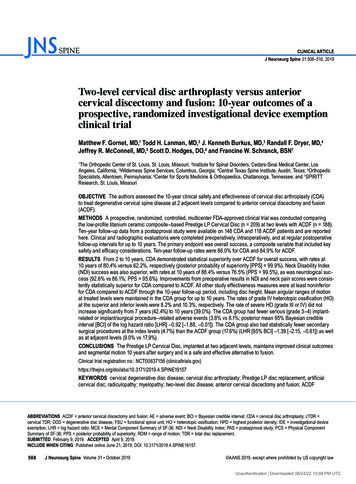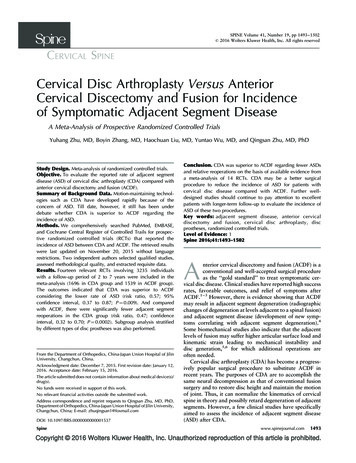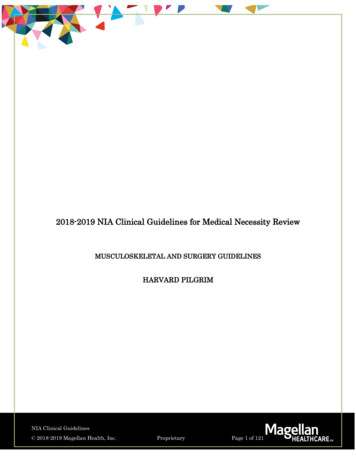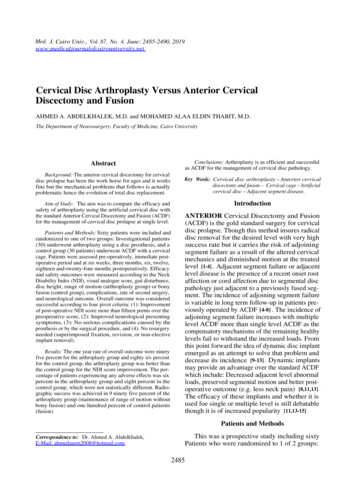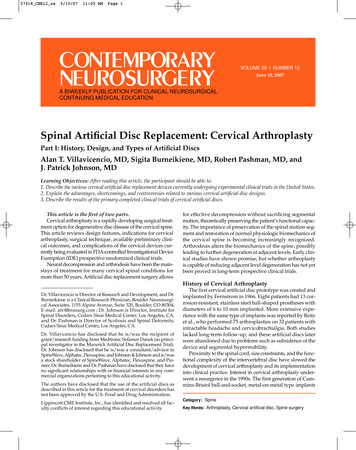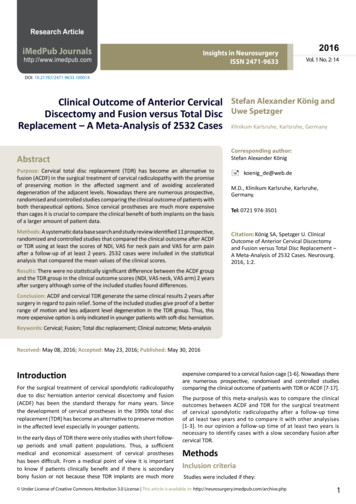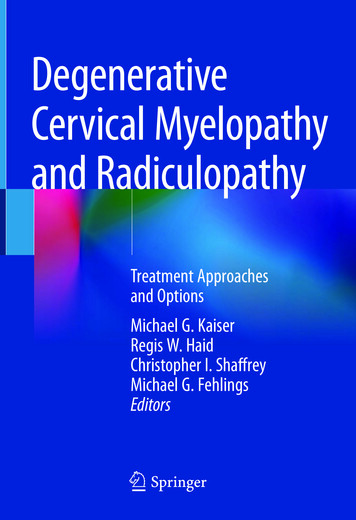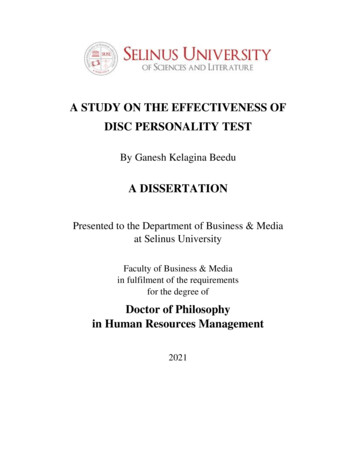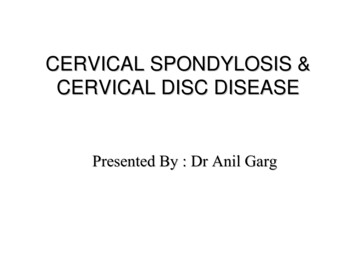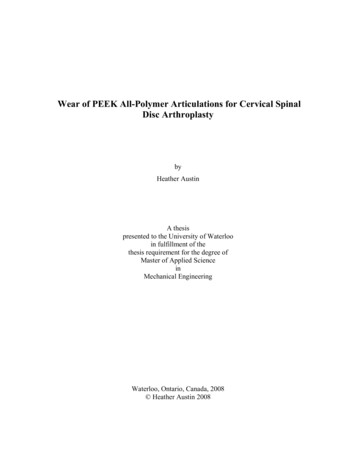
Transcription
Clinical CommissioningPolicy: Cervical DiscReplacement for CervicalRadiculomyelopathy1Reference: NHS England xxx/x/x
Clinical Commissioning Policy:Cervical Disc Replacement for CervicalRadiculomyelopathyFirst published: Month YearPrepared by NHS England Specialised Services Clinical Reference Group forComplex Spinal SurgeryPublished by NHS England, in electronic format only.2
ContentsPolicy Statement . 4Equality Statement. 4Plain Language Summary . 41. Introduction . 52. Definitions . 53. Aim and objectives . 54. Epidemiology and needs assessment . 65. Evidence base . 66. Rationale behind the policy statement . 87. Criteria for commissioning. 98. Patient pathway . 109. Governance arrangements . 1010. Mechanism for funding . 1011. Audit requirements . 1012. Documents which have informed this policy . 1113. Links to other policies . 1114. Date of review . 11References . 11Version Control Sheet . Error! Bookmark not defined.3
Policy StatementNHS England will commission Cervical Disc Replacement for CervicalRadiculomyelopathy in accordance with the criteria outlined in this document.In creating this policy NHS England has reviewed this clinical condition and theoptions for its treatment. It has considered the place of this treatment in currentclinical practice, whether scientific research has shown the treatment to be of benefitto patients, (including how any benefit is balanced against possible risks) andwhether its use represents the best use of NHS resources.This policy document outlines the arrangements for funding of this treatment for thepopulation in England.Equality StatementThroughout the production of this document, due regard has been given to eliminatediscrimination, harassment and victimisation, to advance equality of opportunity, andto foster good relations between people who share a relevant protectedcharacteristic (as cited in under the Equality Act 2010) and those who do not share it.Plain Language SummarySelected patients with nerve or spinal cord entrapment or compression can benefitfrom surgery to the neck (cervical spine). The standard operation is to insert a staticcage into the cervical spine following decompression of the neural tissue. Thisprocedure ultimately results in that segment of the spine becoming fused and rigid.The fusion operation has an excellent track record of success.Cervical Disc Replacement (CDR) is a relatively recent development and isconsidered as an alternative to fusion. It is a procedure in which a mobile disc isplaced into the neck, rather than a static cage. The arguments for CDR are that itmaintains closer-to-normal movement in the neck with improved clinical andradiological outcomes and potentially fewer requirements for future surgery, either atthe operated level or at levels next to the operated level.CDR should be used only in accordance with clinical eligibility criteria, in carefullyselected patients in whom symptoms cannot be adequately controlled withconservative measures.Information on the outcome of treatments for these patients will be collected andconsidered when this policy is reviewed.4
1. IntroductionThis policy considers the use of Cervical Disc Replacement (CDR) or DiscArthroplasty for patients with cervical radiculopathy (nerve compression in the neck)or cervical myelopathy (spinal cord compression in the neck). It reviews theevidence for the use of the device and the patient selection involved when decidingwhich patients are appropriate for the procedure.2. DefinitionsAs the cervical spine ages it develops wear and tear (degenerative) changes.Associated with this degeneration are changes to the cervical disc, which is the partof the cervical spine in between the vertebral bodies (bones in the spine). In somecases this cervical disc degeneration can lead to neurological symptoms and signsand neck pain.The cause of the neurological symptoms related to the pathology of the disc spaceis neural compression, either from a soft disc prolapse or osteophytic (bony)compression or both. Either the spinal cord or the nerve roots (or both) may becompressed leading to myelopathic (relating to spinal cord) or radiculopathic(relating to nerve root) symptoms and signs. The causes of neck pain are less clearbut may be related to instability, loss of normal neck alignment, degeneration of thefacets (joints at the back of the spine) or compression of posterior nerve rootssupplying the neck musculature (posterior rami).When neural compression occurs, and if conservative treatment (includingmedication and targeted local injections) fails, the management consists of surgicaldecompression, often performed through the front of the neck. The pathological discprolapse or ostephytes are removed and the neural tissue decompressed. Thestandard operation for over 60 years has been the anterior cervical discectomy andfusion (ACDF). In this operation the disc is removed and replaced with either thepatient’s own bone, or more latterly, a synthetic cage with bone graft, or substituteinserted into its centre. This is performed to allow the vertebral body above andbelow the disc space to fuse together with a bone bridge. Mobility at this segment ofthe spine is eliminated.There is evidence that, since the ACDF operation removes mobility in that segmentof the spine, the adjacent segments of the spine develop hypermobility with anassociated increased stress and intradiscal pressure. The concern is that thisincrease in stress leads to greater adjacent-segment degeneration and recurrentsymptoms. However the evidence is conflicting and some studies have suggestedthat adjacent-segment degeneration is not linked to the fusion level.3. Aim and objectivesThis policy aims to :1. Determine if CDR is clinically effective in patients with cervical radiculopathy5
and/or cervical myelopathy compared with anterior cervical fusion.2. Determine if CDR is cost-effective in patients with cervical radiculopathyand/or cervical myelopathy compared with anterior cervical fusion.3. Determine if there are any sub-groups for whom CDR is clinically effective inpatients with cervical radiculopathy and/or cervical myelopathy comparedwith anterior cervical fusion.4. Epidemiology and needs assessmentCervical degeneration and disc disease is a common condition that causessignificant morbidity in patients both of working age and into older age. Thesymptoms can be extreme in terms of radicular pain (pain in the arm) and canthreaten spinal cord function, leading to poor balance and dysfuntion of gait andhand function (myelopathy).Treatment for radiculopathy varies from medical management with neuropathicpainkillers, to targeted local steroid injections to decompressive surgery. Treatmentfor progressive myelopathy is surgical decompression and conservative measuresare considered ineffective. Surgery in the form of ACDF is a proven, effectivetreatment in the relief of radiculopathy and in the prevention of progressivemyelopathy.Cervical disc replacement is intended to treat neurological symptoms and neck painassociated with degeneration of the cervical spine in a similar fashion to ACDF. Thedevices were initially developed and implanted in the 1990s. The advantage of CDRis that it achieves neural decompression via exactly the same approach as an ACDFbut with the addition of preserved motion at the operated level. The theoreticaladvantage of this is that there will consequently be less adjacent segment stress,intradiscal pressure and therefore degeneration, resulting in fewer secondoperations to address the pathological consequences of that degeneration.The operations themselves are technically very similar, the only notable differencebeing the type of implant used. Increased time is spent in placement of thearthroplasty device and therefore operative time is marginally increased overall withthe CDR but this is not likely to be significant and is in the order of minutes.5. Evidence baseNICE issued guidance in May 2010 stating that the current evidence shows that thisprocedure is at least as efficacious as fusion in the short term and may result in areduced need for revision surgery in the long term. There were no particular safetyconcerns that were not already known in relation to fusion procedures.Luo demonstrated in his meta-analysis that at 24 months after a one level CDR, theresults were superior to fusion in terms of neurological success, secondary surgicalprocedures, visual analogue scale pain scores and range of motion.6
A review by Mummaneni looking at the long-term results for single-level CDR vsfusion included two FDA studies with follow-up periods of greater than 48 months.The Bryan and the Prestige discs were the implants that were studied. Patients inthe CDR group showed a higher rate of overall success in terms of Neck Disability,neck and arm pain scores and SF-36 physical component scores compared to thefusion group. In addition the rate of adjacent segment disease was lower in the CDRgroup at 60 months (2.9% vs 4.9%). Normal segmental motion was maintained inthe CDR group and the rates of revision and supplemental fixation surgicalprocedures were lower in the CDR group.A paper by Burkus et al published ahead of print reported on the seven-year followup of the Prestige cervical disc. This randomised trial reported that disability indexscores, neck pain, quality of life and rates of maintenance or improvement inneurological status were better after cervical disc replacement. Cumulative rates ofrepeat surgery at the index and at adjacent levels were lower in the discreplacement group than the fusion group.There is contrary evidence that suggests that adjacent segment degeneration (ASD)is not altered by CDR. In the 48-60 month follow-up meta-analysis by Riew, lookingat the Prestige ST, Prodisc-C and Bryan devices, the conclusion was that bothACDF and CDR appear to have similar rates of ASD. This finding is repeated in thepaper by Verma.The follow-up so far (5-7 years) is insufficient to measure ultra-long term differencesin outcomes and revision rates between ACDF and CDR. If similarities are soughtwith large joint arthroplasties it is evident that the results and complications maytake decades to appear. However, in general, CDR is undertaken on patients with amuch lower average age than large joint arthroplasties so there is an even greateremphasis on longevity of the implant with disc replacement. In addition, thecomparison between large joint arthroplasty and CDR varies in a number ofimportant ways. First, there is a gold-standard alternative in cervical surgery, namelyfusion. Secondly, continued motion may lead to overgrowth of bone and tissue intoneural elements, so-called heterotopic ossification (effectively the disc replacementfuses); this is not a concern in joint replacement surgery. Thirdly, a cervical disc isanatomically very different to a hip or knee joint. Answers to the long-term concernsrelating to longevity of the disc are unknown. In a cost-effectiveness comparisonstudy published in 2013, Qureshi et al used a time-span of 20 year life expectancyfor the discs. However, the true lifespan of these implants is not known, nor theconsequences or appropriate management of wear and failure in the future. Furthersurgery may ultimately be required. What form that salvage surgery would take isnot currently in mainstream discussion.In addition the long-term safety of these devices is currently unknown with currentlyunresolved questions surrounding complications such as erosion and peri-prostheticloosening, toxicity of the prosthesis, biocompatibility, heterotopic ossification andimplant migration or subsidence. Again, salvage procedures for such complicationscould conceivably be significant, costly and not without risk.The operating time for CDR is initially expected to be considerably longer that ACDFfor a surgeon new to the technique, however this can be expected to fall as thesurgeon progresses up the learning curve, which is likely to be relatively short.7
Ultimately there are likely to be marginally increased operating times associatedwith CDR since exact placement of the device is more critical than in fusion. Thisincreased time is not thought to be clinically important. Surgeons experienced indisc replacement are reporting negligible differences in operative time therefore thiswill have no impact on theatre resource costs.The duration of hospital stay andblood loss are similar between the procedures. (Luo)Cost-effectiveness has been addressed by a paper from the United States. Qureshiet al’s model indicated that cervical disc replacement yielded 3.94 QALYs comparedwith 1.92 from cervical fusion. Disc replacement dominated cervical fusion, beingboth more effective and less expensive.Care must be taken when relying on data from other healthcare systems and maynot be applicable to the National Health Service. NHSE pays more for CDR than forfusion. This would be reflected in experience since in the UK fusion is carried outwith a relatively inexpensive cage and bone graft substitute whilst a CDR costs onaverage 1000 - 1500 more. Therefore, in terms of implants alone, CDR is themore expensive procedure. When potential increased theatre time is included thecosts increase further. Comparative data for QALYs in England is not available.6. Rationale behind the policy statementMany of these devices have undergone study in the United States for the purpose ofFDA approval. The vast majority have looked at single-level CDR and only the MobiC (by LDR) has been approved for two-level use (Davis). All of the studies havelooked for non-inferiority and as a result many have been approved.The FDA has approved the following discs for surgery at 1 level:Bryan (Medtronic)Prestige ST (Medtronic)Prestige LP(Medtronic)Secure-C (Globus)Prodisc-C (DePuy Synthes)Mobi-C (LDR)There are three main issues to consider with regards to effectiveness:Is the rate of adjacent segment degeneration different?Is there clinical effectiveness?Is it safe?It is evident from the literature review and from the FDA studies that the devices aresuccessful in satisfying non-inferiority criteria and that in many cases appear to havesuperior results when compared to ACDF. Long-term ( 7 year) safety and8
effectiveness is unknown.7. Criteria for commissioningCDR may be indicated for the following diagnoses, in adults over the age of 18, withqualifying criteria, where appropriate. All patients must be discussed in a regionalspinal MDT where the indications and contra-indications should be checked.Treatment can only proceed when the agreement of the regional spinal MDT (whenestablished).Radiculopathy related to 1 or 2 level degenerative disease (either from herniateddisc or spondylotic osteophyte) from C3/4 to C6/7 with or without neck pain that hasbeen refractory to medical or non-operative management.Myelopathy or myeloradiculopathy: related to 1 or 2 level degenerative disease(either from herniated disc or spondylotic osteophyte) from C3/4 to C6/7 with orwithout neck pain that is severe enough to warrant surgical intervention.CDR is NOT clinically indicated in the following scenarios:Neck pain only without radiculopathy or myelopathySymptomatic multi-level disease (3 or more levels) that would require CDR.Osteoporosis or osteopenia(including a medical condition requiring long-term useof steroids)Instability defined as: translation greater than 3mm difference between lateralflexion-extension views at the symptomatic level or 11 degrees of angular differencebetween lateral flexion-extension views at the symptomatic level.Severe spondylosis defined as: greater than 50% loss of disc height or bridgingosteophytes or absence of motion on flexion-extension views at the symptomaticsiteSevere facet joint arthropathyAnkylosing spondylitisSensitivity or allergy to implant materialsPrevious surgery at the involved levelRheumatoid arthritisFracture new or old with anatomical deformityOssification of the posterior longitudinal ligamentMalignancy active in the cervical spineInfection active at the site of the proposed implant or systemic9
The OPCS code for CDR is V361 which maps to HRG HC02 for single level andHC01 for two or more levels.8. Patient pathwayPatients with radiculopathy of greater than 6 weeks who are refractory to medical ornon-operative treatment or patients with myelopathy or radiculomyelopathy of anyduration severe enough to warrant surgery.9. Governance arrangementsCurrently CDR is performed in small numbers throughout England and Wales. Thevast majority of anterior cervical surgery carried out annually is the fusion surgery.Secondary User Service (SUS) data for 2013/14 reveals that 579 patients had CDRversus over 6,000 who underwent a fusion operation.The NICE guidelines from 2010 advised that the procedure should only be carriedout in specialist units where surgery of the cervical spine is undertaken regularly andencouraged further research including the collection of data on preservation ofmobility, occurrence of adjacent segment disease and avoidance of revisionsurgery.Cervical disc replacement should only considered under Specialised Commissioningarrangements and therefore only be carried out in units that are appropriatelycommissioned.All patients must be discussed in a regional spinal MDT (when established) wherethe indications and contra-indications should be checked.10. Mechanism for fundingNHS England is responsible for funding the surgical procedure which is currentlyincluded in National Tariff. This is part of the scope of Complex Spinal Surgery.11. Audit requirementsSpecialised Commissioning arrangements include the mandatory recording ofpatients undergoing CDR into a Spinal Registry. This should include a visualanalogue pain score and EQ-5D.The uncertain longevity and long-term outcomes from CDR make long-term datacollection a vital requirement for the ongoing use of these devices. Clinical andradiological follow-up to five years is recommended as for total hip and knee10
replacements.12. Documents which have informed this policyNational Institute for Health and Care Excellence. Prosthetic intervertebral discreplacement in the cervical spine. (IPG 341). London: NICE 2010.Cervical artificial disc replacement: defining appropriate coverage positions. NorthAmerican Spine Society 2014.NHS England D14/S/a: NHS standard contract for complex spinal surgery (all ages).13. Links to other policiesThis policy follows the principles set out in the ethical framework that govern thecommissioning of NHS healthcare and those policies dealing with the approach toexperimental treatments and processes for the management of individual fundingrequests (IFR).14. Date of reviewThis policy will be reviewed in XXX 2017 unless information is received whichindicates that the proposed review date should be brought forward or delayed.ReferencesLuo J, Huang S, Gong M et al. Comparison of artificial cervical arthroplasty versusanterior cervical discectomy and fusion for one-level cervical degenerative discdisease: a meta-analysis of randomized controlled trials. Euro JOrthopSurgTraumat2014.Published online 18 July.DOI 10.1007/s00590-014-1510-4.K Daniel Riew, Jeannette M Schenk-Kisser et al. Adjacent segment disease and CADR: promises fulfilled? EBSJ Vol3, Issue 1 Supp p 39-46.Verma K, Gandhi SD, Maltenfort M et al. Rate of adjacent segment degeneration incervical disc arthroplasty versus single-level fusion: a meta analysis of prospectivestudies. Spine2013: 38 (26) p2253 – 2257.Burkus JK, Traynelis VC, Haid RW Jr et al.Clinical and radiographic analysis of anartificial cervical disc: 7-year follow-up from the Prestige prospective randomizedcontrolled clinical trial.JNeurosurg Spine 2014.Published online18 Jul§5: 1-13. DOI:10.3171/2014.6.SPINE13996.Davis RJ, Kim KD, Hisey MS et al. Cervical total disc replacement with the Mobi-Ccervical artificial disc compared with anterior discectomy and fusion for treatment of2-level symptomatic degenerative disc disease: a prospective, randomized,controlled multicenter clinical trial. J Neurosurg Spine 2013; 19: 532-45.11
Qureshi SA, McAnany S, Goz V et al. Cost-effectiveness analysis: comparing singlelevel cervical disc replacement and single-level anterior cervical discectomy andfusion. J Neurosurg Spine 2013; 19: 546-54.Praveen Mummaneni, Beejal Y Amin et al. Cervical artificial disc replacement versusfusion in the cervical spine: a systematic review comparing long-term follow-upresults from two FDA trials. EBSJ Vol3, Issue 1 Supppp 59-66.Mummaneni PV, Burkus JK, Haid RW et al. Clinical and radiographic analysis ofcervical discarthroplasty compared with allograft fusion:a randomized controlledclinical trial. J Neurosurg Spine 2007; 6: 198-209.12
Cervical Disc Replacement (CDR) is a relatively recent development and is considered as an alternative to fusion. It is a procedure in which a mobile disc is . The Bryan and the Prestige discs were the implants that were studied. Patients in the CDR group showed a higher rate of overall success in terms of Neck Disability,
